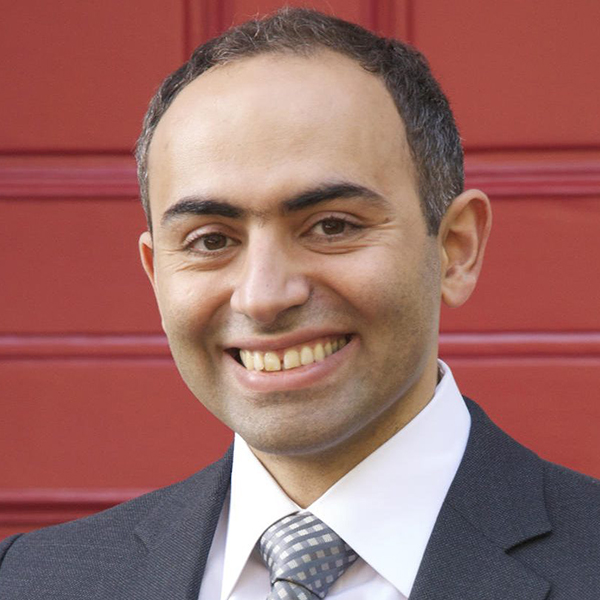NIH Awards $3.1M Grant to Kayhan Batmanghelich for Pulmonary Biomarker Research
AI-driven approach integrates Multi-Modal Data and Biomechanics for Better Diagnosis and Tracking of Chronic Obstructive Pulmonary Disease (COPD)
Kayhan Batmanghelich, Assistant Professor of Electrical & Computer Engineering, Hariri Institute Junior Faculty Fellow and AIR Affiliate at Boston University, was awarded a $3.1 million competitive renewal R01 grant from the National Institutes of Health’s National Heart, Lung, and Blood Institute. With this grant, Batmanghelich will lead transformative research on Chronic Obstructive Pulmonary Disease (COPD) with collaborators from Boston University College of Engineering, University of Pittsburgh School of Medicine and Brigham and Women’s Hospital.
COPD is a progressive and heterogeneous disease affecting over 300 million people worldwide. The project, titled “Integrating Multi-Modal Data and Biomechanics in COPD: Toward Robust and Interpretable Biomarkers for Disease Subtyping and Progression,” aims to overcome critical limitations in current diagnostic tools by developing novel, interpretable biomarkers using advanced artificial intelligence.

“Lung function tests and CT scans are standard for diagnosing COPD, but they don’t capture how the disease progresses,” says Batmanghelich. “Current radiomics lack sensitivity, and most deep learning models are limited, hard to interpret, and sensitive to scan variations.”
Batmanghelich and his team will address these challenges by building on their previous work that used self-supervised deep learning to generate radiomic features that are more generalizable than traditional methods [1]. Their approach integrates multi-modal data, including CT imaging, genetic and genomic data [2], and personalized biomechanical modeling of the tissue [3, 4]. This multi-modal framework will enable more accurate disease subtyping and earlier, patient-specific predictions of COPD progression. A key goal is ensuring that the AI-generated insights are clinically interpretable and trusted by physicians.
“The material properties of lung tissue change due to disease, but direct measurement of these properties (such as tissue stiffness) is typically not feasible. One aim of this proposal is to non-invasively estimate such properties from lung motion, yielding highly interpretable results. If we can further link these estimated properties to other patient data, including genetic and genomic measurements, we can develop novel and clinically meaningful multimodal biomarkers for the disease.” says Batmanghelich.
This work introduces two key innovations: (1) biomechanically-informed neural networks to estimate tissue stiffness from CT scans, and (2) a graph neural network-based AI model that integrates multimodal data across multiple biological scales.
The team is uniquely positioned to achieve these goals. Dr. Batmanghelich, the project lead, has extensive experience in medical imaging and artificial intelligence, while co-investigators Dr. Béla Suki and Dr. Hadi Nia contribute deep specialization in modeling the lung’s biomechanical properties. Suki is a BU Professor of Biomedical Engineering and Materials Science Engineering with decades of experience in developing biomechanical models of the lung. Nia is a BU Assistant Professor of Biomedical Engineering and Materials Science Engineering who has developed an innovative platform—Lung Crystal Rib Cage—that enables high-resolution optical imaging across multiple biological scales. The team also includes outstanding clinical researchers. Peter Castaldi, MD, is a physician-scientist and Associate Professor of Medicine in the Channing Division of Network Medicine at the Brigham and Women’s Hospital, who will serve as a co-investigator on this award. Additionally, Frank Sciurba, MD, is a world-renowned pulmonologist and Professor of Medicine and Director of the Emphysema/COPD Research Center at the University of Pittsburgh School of Medicine who has collaborated closely with Dr. Batmanghelich since 2016.
While focused on COPD, the tools and methods developed through this work may extend to other pulmonary diseases that affect lung biomechanics, offering broader potential impact.
“By uniting data from biology, imaging, and physics through interpretable AI, we’re not just improving COPD care, we’re building a foundation for a new generation of precision diagnostics,” said Batmanghelich. “Our work has the potential to shift how we understand, track, and ultimately treat chronic diseases that affect millions worldwide.”
View the NIH award information here.
[1] Yu K, Sun L, Chen J, Reynolds M, Chaudhary T, Batmanghelich K. DrasCLR: A self-supervised framework of learning disease-related and anatomy-specific representation for 3D lung CT images. Med Image Anal. 2024 Feb;92:103062. doi: 10.1016/j.media.2023.103062. Epub 2023 Dec 9. PMID: 38086236; PMCID: PMC10872608.
[2] Chen J, Xu Z, Sun L, Yu K, Hersh CP, Boueiz A, Hokanson JE, Sciurba FC, Silverman EK, Castaldi PJ, Batmanghelich K. Deep Learning Integration of Chest Computed Tomography Imaging and Gene Expression Identifies Novel Aspects of COPD. Chronic Obstr Pulm Dis. 2023 Oct 26;10(4):355-368. doi: 10.15326/jcopdf.2023.0399. PMID: 37413999; PMCID: PMC10699487.
[3] Pollack BL, Batmanghelich K, Cai SS, Gordon E, Wallace S, Catania R, Morillo-Hernandez C, Furlan A, Borhani AA. Deep Learning Prediction of Voxel-Level Liver Stiffness in Patients with Nonalcoholic Fatty Liver Disease. Radiol Artif Intell. 2021 Sep 29;3(6):e200274. doi: 10.1148/ryai.2021200274. PMID: 34870213; PMCID: PMC8637225.
[4] Ragoza M, Batmanghelich K. Physics-Informed Neural Networks for Tissue Elasticity Reconstruction in Magnetic Resonance Elastography. Med Image Comput Comput Assist Interv. 2023 Oct;14229:333-343. doi: 10.1007/978-3-031-43999-5_32. Epub 2023 Oct 1. PMID: 38827227; PMCID: PMC11141115.
